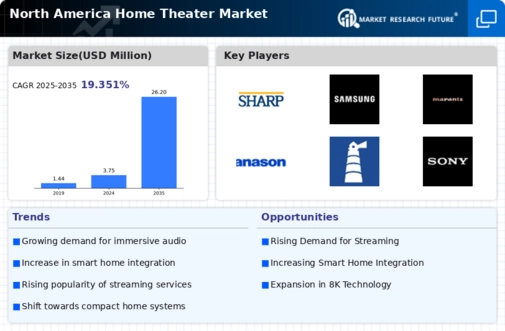Popularity of Streaming Services
The proliferation of streaming services is significantly influencing the home theatre market in North America. With platforms like Netflix, Hulu, and Disney+ offering a vast array of content, consumers are increasingly investing in home theatre systems to enhance their viewing experiences. The convenience of on-demand content has led to a rise in the consumption of high-definition media, which in turn drives the demand for advanced audio-visual equipment. Recent statistics indicate that over 70% of households in North America subscribe to at least one streaming service, highlighting the potential for growth in the home theatre market. This trend suggests that as more consumers seek to replicate the cinematic experience at home, the demand for sophisticated home theatre solutions will likely continue to rise.
Growing Interest in Home Renovations
The trend of home renovations is contributing to the expansion of the home theatre market in North America. As homeowners invest in upgrading their living spaces, there is a growing interest in incorporating dedicated home theatre rooms or enhancing existing entertainment areas. This renovation trend is often driven by the desire for improved aesthetics and functionality, with many consumers seeking to create a more immersive viewing environment. According to industry reports, spending on home improvements is expected to increase by 8% annually, indicating a robust market for home theatre installations. This inclination towards home enhancements suggests that the home theatre market will benefit from increased investments in audio-visual technologies and design.
Rise of DIY Home Theatre Installations
The rise of DIY home theatre installations is reshaping the landscape of the home theatre market in North America. With the availability of user-friendly technology and online resources, consumers are increasingly taking on the challenge of setting up their own home theatre systems. This trend is supported by the growing number of instructional videos and guides available on platforms like YouTube, which empower individuals to create customized setups. The DIY approach not only reduces installation costs but also allows for greater personalization of the home theatre experience. As a result, the market for home theatre components, such as projectors, screens, and sound systems, is likely to see sustained growth, reflecting the evolving preferences of consumers in the home theatre market.
Increased Consumer Spending on Home Entertainment
Consumer spending on home entertainment has seen a notable increase in North America, which is positively impacting the home theatre market. As disposable incomes rise, households are allocating more funds towards enhancing their entertainment experiences at home. This trend is reflected in the growing sales of premium audio-visual equipment, with the market for home theatre systems expected to reach $10 billion by 2027. Additionally, the shift towards remote work has led to more individuals seeking high-quality home entertainment options, further fueling demand. The inclination to create a cinema-like experience at home is becoming a priority for many consumers, suggesting a sustained growth trajectory for the home theatre market.
Technological Advancements in Audio-Visual Equipment
The home theatre market in North America is experiencing a surge due to rapid technological advancements in audio-visual equipment. Innovations such as 4K and 8K resolution displays, along with enhanced sound systems, are becoming increasingly accessible to consumers. The introduction of OLED and QLED technologies has significantly improved picture quality, making home viewing experiences more immersive. Furthermore, the integration of artificial intelligence in sound systems allows for personalized audio settings, enhancing user satisfaction. According to recent data, the market for high-definition televisions is projected to grow at a CAGR of 10% through 2026, indicating a robust demand for advanced home theatre solutions. This trend suggests that consumers are willing to invest in superior technology, thereby driving growth in the home theatre market.

















Leave a Comment